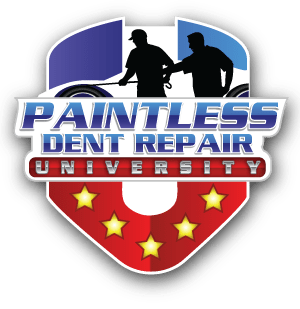FAQs
Paintless Dent Repair FAQs
If you’re interested in becoming successful as a paintless dent repair tech, Rob McDowell has the experience to guide you to success.
These are the common questions about the paintless dent repair process, paintless dent repair training, and specifics about the Paintless Dent Repair University training offerings.
Paintless Dent Repair Training Costs?
The cost of getting started depends on the quality level of training, tools, and travel expenses. There is no industry standard paintless dent repair training cost. It really depends on what you want to achieve with paintless dent repair skills and how fast you desire to achieve a certain skill level. The adage “You get what you pay for” is very appropriate for learning paintless dent repair. A more detailed explanation is outlined in the PDR Professor’s blog post “How to choose dent repair training.” The factors you need to consider are:
- High-Quality PDR Industry-Respected Trainer
- PDR Industry Manufactured Quality Dent Repair Tools
- Travel Expenses
- Hotel/Meal Expenses
Is PDR Difficult to Learn?
Yes, because paintless dent repair is a high-end craft that takes time and effort to perfect. It takes determination and perseverance to invest the time and become a master at this art form. But anyone can learn paintless dent repair!
Who Can Learn & Become a PDR Professional?
Anyone! Over the years, we have seen men and women of all ages and backgrounds. The oldest PDR professional we know is a 70-year-old gentleman with no intention of retiring anytime soon! The deciding factors are:
- Correctable Eyesight
- Physically Fit and Good Flexibility.
- A Persevering and Determinative Attitude
- Willing to Follow Instructions
DVD Or Video PDR Training?
DVD or video training is fine as a supplement to hands-on training, but it is not a substitute. Due to this medium being two-dimensional, it has limitations. It will take significantly longer to become a professional due to the lengthy time and steep learning curve associated with this method of instruction.
What Is A "Training Mill"?
A training mill is a training organization that instructs large groups of people. Similar to the superstore concept, they typically offer the lowest prices and the largest selection of reconditioning courses. But that method has its drawbacks. They do not utilize industry experts, hands-on training is limited, students are treated as just a number or a product, and after-class support is either limited or nonexistent. The failure rate is very high, and few students become industry professionals.
Why Is Certified Paintless Dent Repair University Different?
We are different in the following aspects:
- We are a paintless dent repair industry-respected school.
- Limited Class Size (4 Students Maximum)
- Hands-On Mentor Directed Learning Environment
- Cutting-Edge Paintless Dent Repair Industry Techniques
- Included After Training Alumni Care Program
How Long Are the Courses?
Each course is 1 week.
Where Are the Classes Located?
Classes and testing are conducted in our state-of-the-art facility near Louisville, Kentucky. We prefer our facility to maintain a controlled training environment to enhance learning. At times, we will conduct onsite training for individuals or groups. The pricing is customized, and you can call 502-345-0708 for a quote.
What If I Need More Training?
As an alumni benefit, students are entitled to lifetime refresher training free of charge. As space is available, students are welcome to attend as often as desired. We are committed to our students learning and developing the art of paintless dent repair.
Is There Any Sort of Certification?
Paintless Dent Repair University offers Technician Level paintless dent repair certification, which is awarded upon completion of the class. We offer free certification upgrade testing once a year. Details can be requested with certification standards and achievement levels.
How Many People in a Paintless Dent Repair Class?
There is a maximum of 4 students. We strive to maintain a small student-to-instructor ratio to maximize instructor-student interaction.
